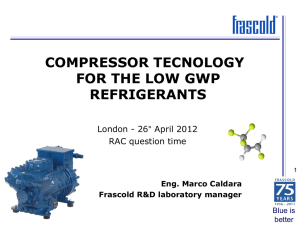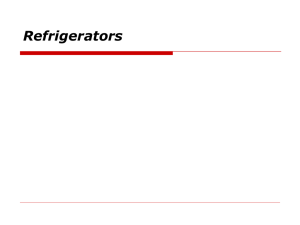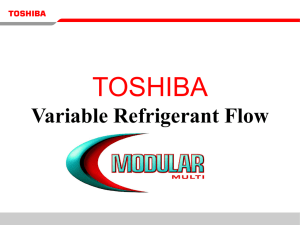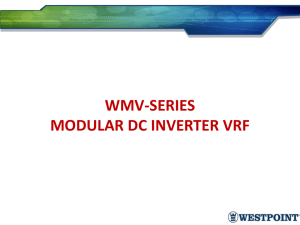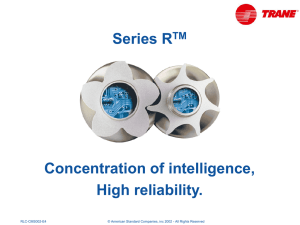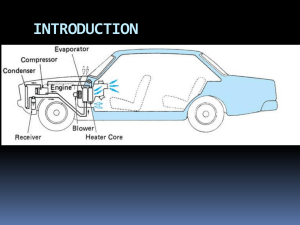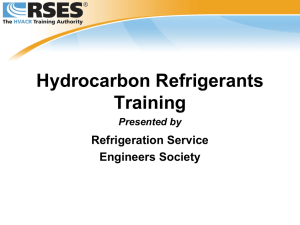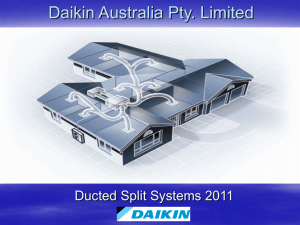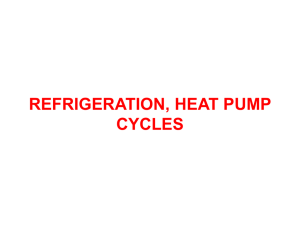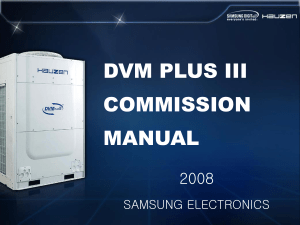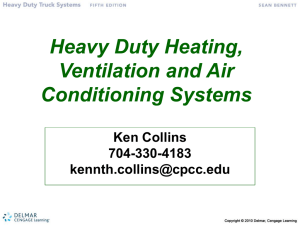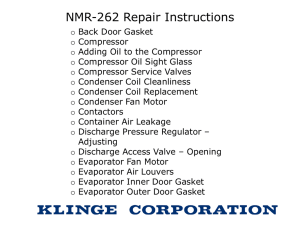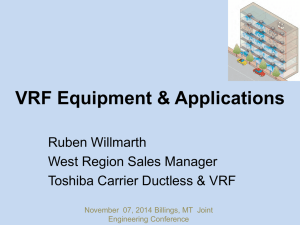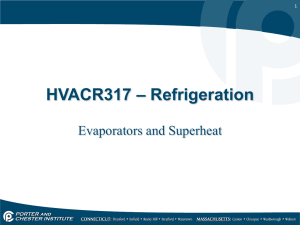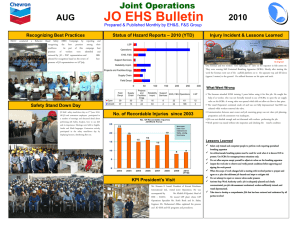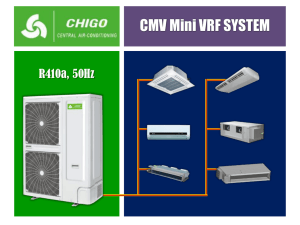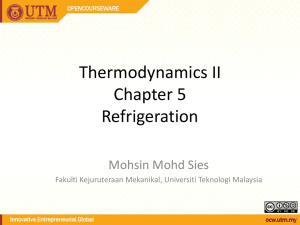Product Introduction
advertisement
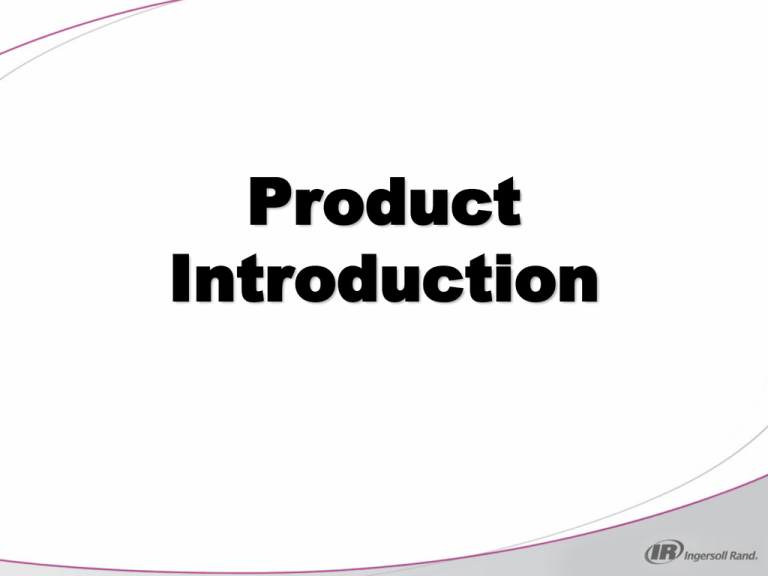
Product Introduction Product Introduction The Multi-Split Inverter Heat Pump System Overview The Multi-Split Heat Pump System is a multi zone capable heat pump that comes in capacities of 18,000, 24,000, 30,000 and 42,000 BTUH models. The system connects to indoor wall mounted units. The comfort conditions are set using a remote control. The Multi-Split system features an inverter driven variable speed twin rotary compressor. The compressor can operate at a frequency range of 1 Hz to 130 Hz. The operating speed of the compressor is determined by internal software within the inverter drive control board. The inverter drive board measures system operating pressure and temperature to determine the proper operating speed of the compressor. Should an abnormal or out or range condition be sensed, the inverter control board will take preventative measures by adjusting frequency or shutting down the system. Compressor Product Introduction The Multi-Split Inverter Heat Pump System Overview Indoor Unit The indoor wall units have digital displays that indicate comfort setting conditions and diagnostic code information. The wall units contain the evaporator coil, remote control receiver, indoor fan motor, louver movement motor and temperature sensors. All information gathered by the indoor wall unit is sent to the outdoor unit inverter board where the operational decisions are made. The remote control and temperature information is sent on a data line that connects the indoor unit to the outdoor unit. Product Introduction The Multi-Split Inverter Heat Pump System Overview The Multi-Split system can operate in cooling or heating mode operation. The mode of operation is controlled by the first calling wall unit. If the first unit calls for cooling mode and a second calls for heating mode, the cooling mode call will be satisfied first. The system will then switch over to heat mode to satisfy the call for heat. The systems use refrigerant R-410A and come pre-charged for up to 164 feet of total combined refrigerant line length (See Charging chapter for total lineset length calculation example). The factory charge level is printed on the outdoor unit nameplate. The maximum allowable line lift distances vary for different models. Refrigerant Pipe must not exceed 16 ft. for 18K models, or 33 ft. for 24K, 30K, and 42K models. The refrigerant oil used with these systems is PVE oil. There is no situation that would require addition of oil to the system. The 042 unit has an oil separator located at the discharge line of the compressor to return oil directly into the suction intake line to the compressor during running operation. Regardless of size, all of the systems have an Oil Return Mode operation that will run the system in a manner that oil is rapidly returned to the compressor should the need arise. The operating voltage for the systems is 208/230 volt single phase. Product Introduction The Multi-Split Inverter Heat Pump System Overview Operating Ranges The operating temperature range for Cooling Mode is from –1F up to 110F. The operating temperature range for Heat Mode operation is 14F-74F. Condensate Pumps Accessory condensate pumps are available for these systems. The condensate pumps are field supplied Aspen pumps. Product Introduction The Multi-Split Inverter Heat Pump System Equipment Combinations The approved combinations of indoor and outdoor unit matches are shown here: 24 & 36 High wall indoor units are not compatible with multi-split systems as of January, 1st 2013. Refer to ARI data for approved combinations. Product Introduction Refrigerant Circuit Operation (18,24,30 Models) Cooling Mode The compressor, indoor fan motor and outdoor fan motor are energized. The 4-way reversing valve is de-energized. The compressor frequency is determined by the temperature setting of the remote controls and the room temperature information received from the indoor units. 1) Hot gas is discharged to the discharge silencer. The discharge temperature sensor monitors the temperature of the discharge gas. A high pressure switch monitors the pressure of the refrigerant to ensure it is not abnormally high. 2) The hot gas is discharged through the 4 way valve and enters the outdoor coil. The discharge gas is condensed and slightly subcooled. (There are no pressure ports to measure the pressure or take a subcooling reading.) 3) The subcooled liquid enters a liquid drier where debris and moisture are filtered. 4) The subcooled liquid enters the front of the four EEV valves labeled A1 through D1. If the corresponding wall unit (in this example A) is calling for cooling operation, the EEV will open and regulate to about a 10F superheat level. The non calling wall unit EEV valves will remain closed. (The compressor frequency is varied to maintain proper pressure regardless of the number of zones calling.) The EEV will adjust its metering size based upon the Liquid and Gas pipe temperature sensor readings. (The adjustment process is controlled by the Inverter board.) Product Introduction Refrigerant Circuit Operation (18,24,30 Models) Cooling Mode 5) The refrigerant leaving the EEV valve is at a low pressure low temperature saturated state. The refrigerant enters the liquid line where it is directed to the indoor wall unit coil. (The refrigerant leaving the EEV valve enters what we know as a liquid line but it is actually a saturated refrigerant line or extension of the evaporator circuit. Because it is cold, it must be insulated.) The cold saturated refrigerant enters the indoor wall unit coil where it absorbs heat being pulled across the coil surface by the indoor fan motor. The refrigerant liquid flashes to a vapor and is superheated to about 10F. The indoor coil tube temperature sensor monitors the temperature of the refrigerant as it leaves the evaporator circuiting. 6) The superheated vapor is returned on the vapor line to the 4 way valve. 7) The refrigerant is then directed to an accumulator where any liquid and vapor are separated. 8) The refrigerant vapor is returned to the compressor and the cycle repeats. During the operation of the cycle, the inverter board will monitor system temperature and pressure. If a frequency adjustment is needed, the system will respond accordingly. Product Introduction Refrigerant Circuit Operation (18,24,30 Models) Cooling Mode Product Introduction Refrigerant Circuit Operation (18,24,30 Models) Heating Mode The compressor, indoor fan motor and outdoor fan motor are energized. The 4-way reversing valve is energized. The compressor frequency is determined by the temperature setting of the remote controls and the room temperature information received from the indoor units. 1) Hot gas is discharged to the discharge silencer. The discharge temperature sensor monitors the temperature of the discharge gas. A high pressure switch monitors the pressure of the refrigerant to ensure it is not abnormally high. 2) The hot gas is discharged through the 4 way valve where it is directed to ALL indoor wall units. The hot gas travels to the indoor wall unit coils via the vapor line which is now a hot gas line. All of the wall unit coils get hot. Only the zones that are calling for heat mode will run the indoor fan. 3) The hot gas refrigerant entering the wall units that are calling for heat will condense to a saturated mix and then be slightly subcooled. The refrigerant exits the indoor wall unit coils and enters the small liquid line. 4) The refrigerant is returned to the outdoor unit and enters a filter drier. The drier protects the EEV from debris. The EEV valves will drop the pressure of the liquid and will maintain 10F superheat. 5) The cold metered refrigerant is then directed to the outdoor coil which is acting as an evaporator coil. The outdoor coil will gain heat from the outdoor air and the cold saturated refrigerant will flash to a saturated mix. The saturated refrigerant is then superheated to 10F. 6) The superheated vapor enters the 4 way valve where it is directed to the accumulator. The accumulator will prevent liquid floodback to the compressor. 7) The superheated suction gas enters the compressor and the cycle repeats. Product Introduction Refrigerant Circuit Operation (18,24,30 Models) Heating Mode Product Introduction Refrigeration Circuit Components Product Introduction Defrosting The system may enter defrost mode whenever defrosting or oil return are needed. The defrost cycle is used for both purposes. The difference is the time and initiation limits which are covered in the Functions Section. During defrost mode, the system reverses to the cooling mode and shuts the outdoor fan motor off. The compressor will be run at a pre-determined frequency that is calculated by the Inverter board. The indoor unit will display a Code H1 while defrosting is taking place. The system will run until the defrost termination conditions are met. If the system is running an Oil Return Mode, the termination time will be 5 minutes. This cycle will continue until the call for heating ends. Product Introduction 042 Model Differentiation The 042 model has an additional refrigerant accessory called an oil separator. The oil separator is located at the discharge line connection to the compressor. The separator a capillary tube that connects to the suction inlet of the compressor. Oil Separator Low Pressure Switch The separator traps refrigerant oil during running operation and returns it to the compressor via the capillary tube. The capillary tube prevents hot gas from being directed back into the suction side of the compressor. The oil separator discharge connects directly to the hot gas inlet to the 4 way valve. The 042 model also has an additional pressure switch that is a Low Pressure Switch. The switch will open if abnormally low pressure is detected.)
